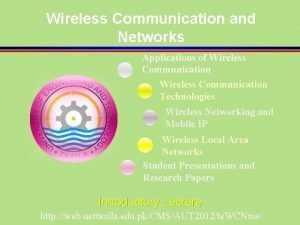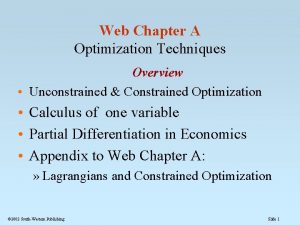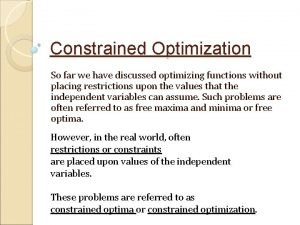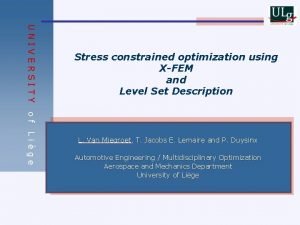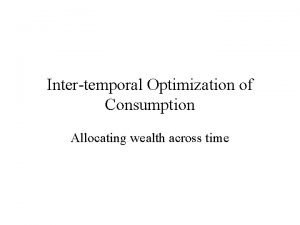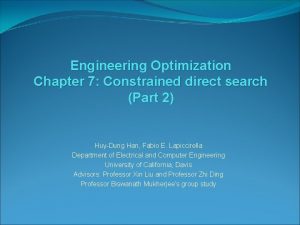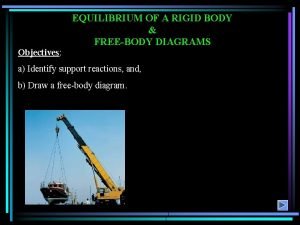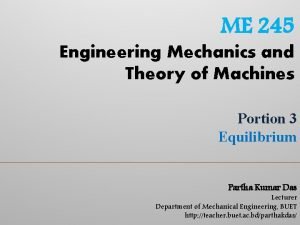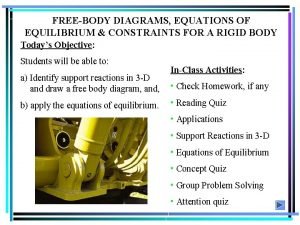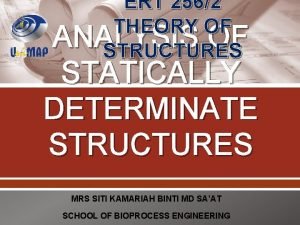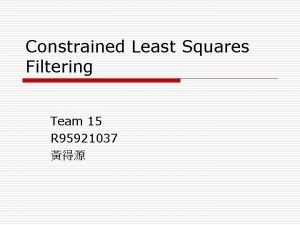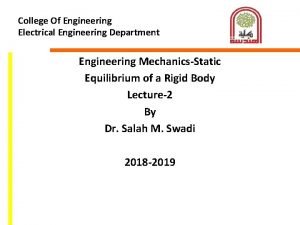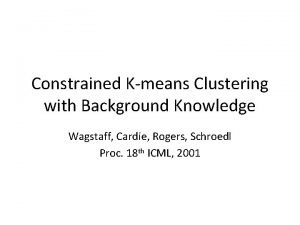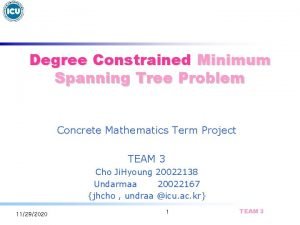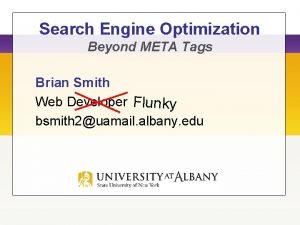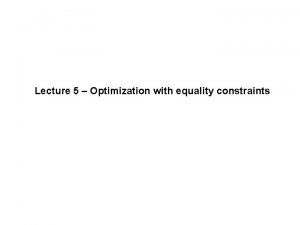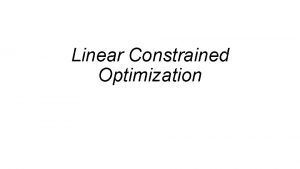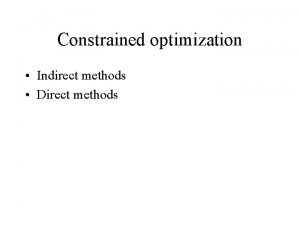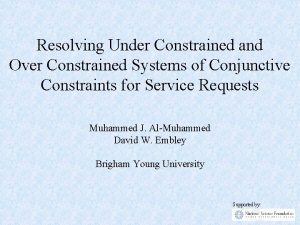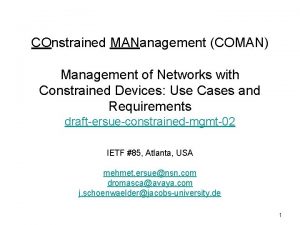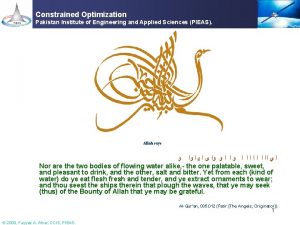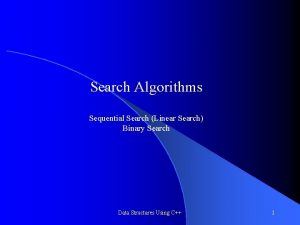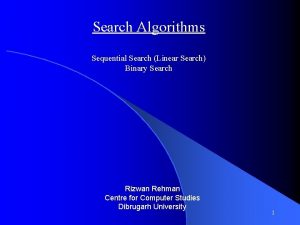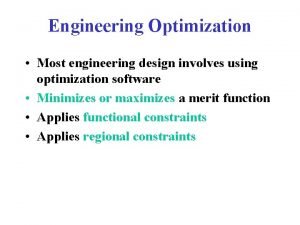Engineering Optimization Chapter 7 Constrained direct search Part
























- Slides: 24

Engineering Optimization Chapter 7: Constrained direct search (Part 2) Huy-Dung Han, Fabio E. Lapiccirella Department of Electrical and Computer Engineering University of California, Davis Advisors: Professor Xin Liu and Professor Zhi Ding Professor Biswanath Mukherjee’s group study

7. 3 RANDOM-SEARCH METHODS �Purpose �Locating feasible starting points �Locating the vicinity of the optimum � 2 methods �Direct Sampling Procedures �Strategies based on random-search procedures.

7. 3. 1 Direct Sampling Procedures. Simultaneous search �Randomize & find the optimum �To achieve the optimum with 90% confidence and the number of samples is in the order of �Eg:


Sampling with interval reduction �Series of Q simultaneous blocks. �P point per blocks �The best point of the pervious block initializes the current block. �The current block is executed with a reduced variable sampling range.

Sampling with interval reduction �Inputs �Initial feasible �Range estimate �reduction factor

Sampling with interval reduction �For each block q=1. . Q.


Example 7. 4 Fuel Allocation in Power Plants � 2 electric power generators �Combined power �Operating range �Generator 1 �Oil required �Gas required �Generator 2 �Oil required �Gas required �Fuel gas limitation: less than 10 unit/h

Example 7. 4 Fuel Allocation in Power Plants (cont. ) �Fuels can be combined in an additive fashion �to generate we need �Determine the output rate of each generator and the fuel mix fractions so as to minimize the total power consumption

Example 7. 4 Fuel Allocation in Power Plants (cont. ) �Minimize the oil consumption �Subject to �Availability of gas �Ouput power requirement

Example 7. 4 Result �Sampling with reduction interval method �Initial solution �Initial range estimate �Result �Cost � 0. 1% of the optimum: 55 blocks x 100 samples � 0. 01% of the optimum: 86 blocks x 100 samples

7. 3. 2 Combined Heuristic Procedures �Combine random sampling with heuristic rules �We investigate 2 methods �Adaptive Step-size random search �Combinatorial Heuristic Method

Adaptive Step-size Random Search �Search direction: random �Step length in that direction is determined by the previous history of successes and failures �If 2 successive steps lead to improvement, increase step size. �If M steps lead to no improvement, decrease step size �It finds a local optimum.

Adaptive Step-size Random Search �Input �Increase factor when success �Decrease factor when failure �Number of failure �Initial point �Initial �Step size �Failure counter

Adaptive Step-size Random Search �Step 1: �generate random direction vector �Calculate the next point �Step 2: � � �Step 3 � �

Adaptive Step-size Random Search �Step 4: �Step 5: � Check termination rule, if not, go to step 1

Adaptive Step-size Random Search

Combinatorial Heuristic Method �Approach �Discretizing the range of the independent variables �Randomized search over the resulting finite grid of possible solutions. �Step 1 (Initial step) �Given feasible starting point �For each variable , execute the loop of steps

Combinatorial Heuristic Method �Step 2: Optimize the i-th variable, (others are fixed) �(a) If found none, goto step 2 with variable i+1. �(b) �(c) Look ahead search � (i) if not goto step 2(a) with variable i+1 � (ii) find the best point and keep the value of i-th variable. �(d) If i=N, goto step 3. � Otherwise, goto step 2(a) with variable (i+1)

Combinatorial Heuristic Method �In step 2, a grid of points is generated.

Combinatorial Heuristic Method �Step 3: Special for i=N �Step 4: Check the termination. If not satisfied, go to step 2 with variable i=1

Discussion �Random-sampling-based search �Low-dimensionality problems �Generating good starting points for more sophisticated algorithm �If sampling strategy that covers most of the feasible region, it may locate the vicinity of the global optimum. �Identify the approximate neighborhood of the minimum �Quite effective for severely nonlinear problems that involve multiple local minima, low dimensionality.

Summary �Find constraint optima using only objective and constraints �Eliminate equality constraints. �Feasible starting point by randomization �Premature termination: if searches along a fixed set of directions. �Complex method �could fail if the feasible region is not convex. �Random-search: �Sequential sampling is preferable to simultaneous sampling. �Generate good feasible starting points. �Identify the vicinity of global solutions for problems with multiple local optima.
 Constrained nodes and constrained networks
Constrained nodes and constrained networks Constrained nodes and constrained networks
Constrained nodes and constrained networks Constrained nodes and constrained networks
Constrained nodes and constrained networks Constrained and unconstrained optimization in economics
Constrained and unconstrained optimization in economics Constrained optimization substitution method
Constrained optimization substitution method Constrained optimization
Constrained optimization R optimization
R optimization Search engineering optimization
Search engineering optimization What is related constrained diversification
What is related constrained diversification Operational relatedness is created by
Operational relatedness is created by Constraints and statical determinacy
Constraints and statical determinacy Improperly constrained
Improperly constrained Simulation phases of systemverilog verification
Simulation phases of systemverilog verification Tower crane free body diagram
Tower crane free body diagram Statically determinate and indeterminate structures
Statically determinate and indeterminate structures Explain the constrained least square filtering.
Explain the constrained least square filtering. Improperly constrained
Improperly constrained Billenko
Billenko Rational constrained choice
Rational constrained choice Crossword puzzle csp
Crossword puzzle csp Scheduling resources and costs
Scheduling resources and costs Degree constrained spanning tree
Degree constrained spanning tree Scheduling time-constrained projects focuses on resource
Scheduling time-constrained projects focuses on resource Trellian keyword discovery tool
Trellian keyword discovery tool Search engine optimization for orthopedic practices
Search engine optimization for orthopedic practices

